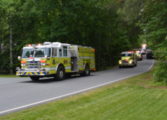Contributed by Mike Feazel
Marvin Moss will step down as president of the Fluvanna Historical Society after a Sept. 28 special event, capping his decades as what one county native called Fluvanna’s “president of everything.”
That’s hardly an overstatement. Moss has been chair of the Fluvanna County Board, president of the Fluvanna Historical Society for 25 years, president of the Fluvanna Heritage Trail Foundation, chair of the Rivanna River Commission, president of the Fluvanna Friends of Rural Preservation and a member of numerous committees and commissions at the state and national level.
Among the Fluvanna projects Moss led or worked with groups on are the new high school, restoring the historic courthouse, designing the new courthouse and library, creating the Palmyra Village Park, designing the Rt. 15 bridge in Palmyra, the Heritage Trail organization, the picnic shelters at Pleasant Grove, getting $750,000 in funding to restore the Pleasant Grove House, the Palmyra Fire Station, helping raise almost $300,000 for the Fluvanna Farm Heritage Museum, convincing county landowners to place more than 5,000 acres of open space under conservation or historic easements, buying the CSX rail right-of-way in Palmyra to convert into a walking trail, Maggie’s House, the Holland-Page Place log cabin museum, and with Fathers Mefodil and Kyrill establishing the first Eastern Orthodox monastery in the county at Glen Burnie..
For all of that, Moss was named Virginia’s “Unsung Hero” of 2016, an award given annually statewide to a volunteer leader who has had a major impact on their locality. “None of what I’ve done here would have been possible absent the enthusiastic support of the non-profits and our elected officials,” Moss said.
“It is remarkable to think about the impact Marvin Moss has had on the extensive positive developments in the county,” said friend Kathy Swenson-Miller. “Things would be tremendously different if he had not been here,” noted Judy Mickelson, the first executive director of the Fluvanna Historical Society. “He is a visionary — not in the details so much as his ability to recognize how things can be better and more beautiful.”
One key role Moss played has been developing public-private partnerships with the county and using them to raise money for county projects, much of it from federal and state grants, but also from individuals and foundations. Moss estimated his efforts helped net more than $3 million for Fluvanna projects, which he noted is money Fluvanna taxpayers didn’t have to spend. ”No other county our size has done anything like that,” he said. “I’m very proud of that.”
“Marvin helped Fluvanna become stronger in many ways, both as a visionary and a fundraiser,” said multi-generation Fluvanna native Overton McGehee. He and others said one of the keys was Moss’ long experience on Capitol Hill, often working with grants and grant-giving organizations, so he knew where money might be and how to apply for it. “He knows how things work and the things you need to do to get them,” Mickelson said.
The Fluvanna Historical Society, whose membership significantly expanded under his leadership to over 400, has been Moss’ longest-running interest in the county. Mickelson said he has been key to all the historic building restorations, as well as to obtaining the many historic easements that keep Fluvanna rural.
Moss said he didn’t plan to work that hard when he retired from a top Capitol Hill job to move to Palmyra, though he didn’t want to get bored either.
Having restored his historic Glen Burnie country home near Palmyra and placing it on the National Register of Historic Places. Moss’ interest in history led him first to the Fluvanna Historical Society.
It was actually a form of kismet that brought Moss to Palmyra in the first place. He had been looking to buy a historic home in his native Maryland, but none were easily available. A realtor told him about Glen Burnie and he decided to take a look in 1991. He happened to arrive when the property’s field of daffodils was in full bloom, and it was love at first sight, he said. He admits he may not have fully anticipated the years of renovation that would return the house to its historic roots. He didn’t move in fulltime until 1995.
“It became apparent to me almost immediately that the county was struggling to deal with the challenges of rapid growth,” Moss said, noting only Loudoun County was faster-growing in Virginia in the early 2000s. “That’s when I realized I could be very useful for Fluvanna.”
“I had a vision of what could be done and knew how to bring the resources together to make it possible,” Moss said. He cited the many public-private partnerships that he helped create, and their ability to generate support from all the organizations involved.
Restoring Fluvanna’s historic old courthouse is among the most important ongoing projects, Moss said. Called the “Acropolis of Palmyra” by one art historian, the courthouse dates from 1830 and was designed by John Hartwell Cocke as the first Greek Revival county courthouse in Virginia.
The courthouse has sustained some structural damage, and the full restoration will cost nearly $3 million, only a small percentage of which will be paid for by county taxpayers. In another private/public partnership with the county, Kathleen Kilpatrick, who will replace Marvin as president of the society in October, led efforts to restore it and has raised over $1.1 million for it. “The average taxpayer just doesn’t understand how important these public-private partnerships are in getting things done while protecting taxpayers,” Moss said.
Some of Moss’ focus has also been on master planning for the county, primarily assuring that its rural aspects be preserved while providing room for appropriate business and other growth. “We had a golden opportunity to develop a logical plan for development,” he said.
Moss isn’t worried he’ll get bored as he reduces his community involvements, he said, saying he “will continue to help in any way I can. Few people recognize what the historical society, the heritage trail and other community organizations have done to make Fluvanna a more interesting and connected community. We should all be proud of what they have done.”
One major new development is the historical society’s Marvin Moss Legacy Endowment Fund, which will begin serious fundraising efforts at the Sunday, Sept. 28, Celebration of Marvin, 1-4 p.m. at Pleasant Grove. The family-friendly celebration will include musical entertainment, refreshments, tributes to Moss, and an opportunity to contribute to the fund. (RSVPs are requested to bit.ly/marvinmoss2025 or 434-589-7910.
Moss background:
1959 – Graduated from West Point;
1969 – Resigned from Army as major;
1970 – Joined Congressional staff of Congressman Goodloe Byron (D, MD);
1977-1995 — Chief of Staff, Senator Paul Sarbanes (D, MD);
1991 – Purchased historic Glen Burnie in Palmyra;
1995 – Retired from Senate staff and moved to Palmyra fulltime;
1995-2002 – Presidential appointee to National Historical Publications and Records Commission at the National Archives, chairing its Executive Committee for two years;
1997- Execute Director of comprehensive study of the U.S. Naval Academy;
1999-2004 – member, Virginia Capital Square Preservation Council;
2004-2009 — Member and chair, Fluvanna County Board of Supervisors;
2000-2025 — President, Fluvanna Historical Society.




